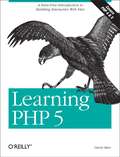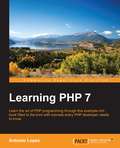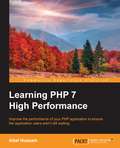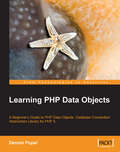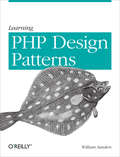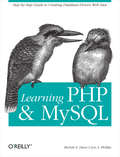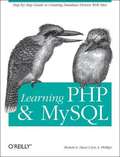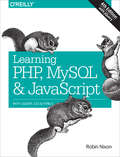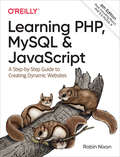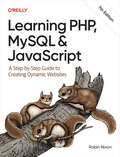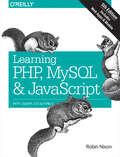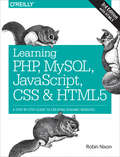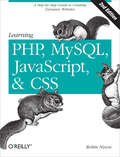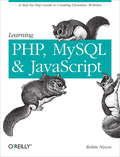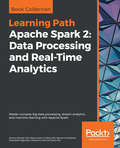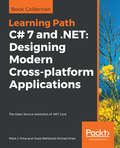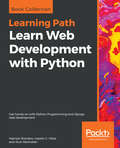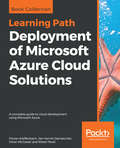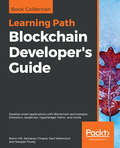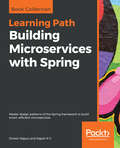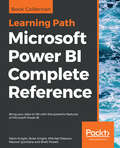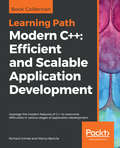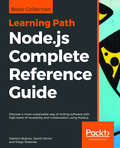- Table View
- List View
Learning PHP 5
by David SklarPHP has gained a following among non-technical web designers who need to add interactive aspects to their sites. Offering a gentle learning curve, PHP is an accessible yet powerful language for creating dynamic web pages. As its popularity has grown, PHP's basic feature set has become increasingly more sophisticated. Now PHP 5 boasts advanced features--such as new object-oriented capabilities and support for XML and Web Services--that will please even the most experienced web professionals while still remaining user-friendly enough for those with a lower tolerance for technical jargon. If you've wanted to try your hand at PHP but haven't known where to start, then Learning PHP 5 is the book you need. If you've wanted to try your hand at PHP but haven't known where to start, then Learning PHP 5 is the book you need. With attention to both PHP 4 and the new PHP version 5, it provides everything from a explanation of how PHP works with your web server and web browser to the ins and outs of working with databases and HTML forms. Written by the co-author of the popular PHP Cookbook, this book is for intelligent (but not necessarily highly-technical) readers. Learning PHP 5 guides you through every aspect of the language you'll need to master for professional web programming results. This book provides a hands-on learning experience complete with exercises to make sure the lessons stick. Learning PHP 5 covers the following topics, and more:How PHP works with your web browser and web server PHP language basics, including data, variables, logic and looping Working with arrays and functions Making web forms Working with databases like MySQL Remembering users with sessions Parsing and generating XML Debugging Written by David Sklar, coauthor of the PHP Cookbook and an instructor in PHP, this book offers the ideal classroom learning experience whether you're in a classroom or on your own. From learning how to install PHP to designing database-backed web applications, Learning PHP 5 will guide you through every aspect of the language you'll need to master to achieve professional web programming results.
Learning PHP 7
by Antonio LopezLearn the art of PHP programming through this example-rich book filled to the brim with tutorials every PHP developer needs to know About This Book * Set up the PHP environment and get started with web programming * Leverage the potential of PHP for server-side programming, memory management, and object-oriented programming (OOP) * This book is packed with real-life examples to help you implement the concepts as you learn Who This Book Is For If you are a web developer or programmer who wants to create real-life web applications using PHP 7, or a beginner who wants to get started with PHP 7 programming, this book is for you. Prior knowledge of PHP, PHP 7, or programming is not mandatory. What You Will Learn * Set up a server on your machine with PHP * Use PHP syntax with the built-in server to create apps * Apply the OOP paradigm to PHP to write richer code * Use MySQL to manage data in your web applications * Create a web application from scratch using MVC * Add tests to your web application and write testable code * Use an existing PHP framework to build and manage your applications * Build REST APIs for your PHP applications * Test the behavior of web applications with Behat In Detail PHP is a great language for building web applications. It is essentially a server-side scripting language that is also used for general purpose programming. PHP 7 is the latest version with a host of new features, and it provides major backwards-compatibility breaks. This book begins with the fundamentals of PHP programming by covering the basic concepts such as variables, functions, class, and objects. You will set up PHP server on your machine and learn to read and write procedural PHP code. After getting an understanding of OOP as a paradigm, you will execute MySQL queries on your database. Moving on, you will find out how to use MVC to create applications from scratch and add tests. Then, you will build REST APIs and perform behavioral tests on your applications. By the end of the book, you will have the skills required to read and write files, debug, test, and work with MySQL. Style and approach This book begins with the basics that all PHP developers use every day and then dives deep into detailed concepts and tricks to help you speed through development. You will be able to learn the concepts by performing practical tasks and implementing them in your daily activities, all at your own pace.
Learning PHP 7 High Performance
by Altaf HussainImprove the performance of your PHP application to ensure the application users aren't left waiting About This Book * Make the optimum use of PHP coding to improve your programming productivity * Leverage the potential of PHP for server-side programming, memory management, and object-oriented programming * Packed with real-life examples to help the readers implement concepts as they learn Who This Book Is For This book is for those who have basic experience in PHP programming. If you are developing performance-critical applications, then this book is for you. What You Will Learn * Setup high performance development and production environment for PHP 7 * Discover new OOP features in PHP 7 to achieve high performance * Improve your PHP applications' performance * Attain improved database performance * Benchmark PHP applications to optimize them * Write quality code by learning to improve code reusability, simplicity, and expressiveness * Get rid of the bottlenecks in your PHP 7 applications by writing PHP code optimally * Tackle issues related to web applications, such as high user dependency and large datasets In Detail PHP is a great language for building web applications. It is essentially a server-side scripting language that is also used for general-purpose programming. PHP 7 is the latest version, providing major backward-compatibility breaks and focusing on high performance and speed. This fast-paced introduction to PHP 7 will improve your productivity and coding skills. The concepts covered will allow you, as a PHP programmer, to improve the performance standards of your applications. We will introduce you to the new features in PHP 7 and then will run through the concepts of object-oriented programming (OOP) in PHP 7. Next, we will shed some light on how to improve your PHP 7 applications' performance and database performance. Through this book, you will be able to improve the performance of your programs using the various benchmarking tools discussed. At the end, the book discusses some best practices in PHP programming to help you improve the quality of your code. Style and approach The book is a step-by-step guide to improve the quality of your code in PHP through real-time examples. The book takes a practical approach to improving the quality of your code.
Learning PHP Data Objects
by Dennis PopelThis book describes the topic first and then gives step-by-step instructions on how to go about a particular example. PHP developers who need to use PDO for data abstraction.
Learning PHP Design Patterns
by William SandersBuild server-side applications more efficiently—and improve your PHP programming skills in the process—by learning how to use design patterns in your code. This book shows you how to apply several object-oriented patterns through simple examples, and demonstrates many of them in full-fledged working applications.Learn how these reusable patterns help you solve complex problems, organize object-oriented code, and revise a big project by only changing small parts. With Learning PHP Design Patterns, you’ll learn how to adopt a more sophisticated programming style and dramatically reduce development time.Learn design pattern concepts, including how to select patterns to handle specific problemsGet an overview of object-oriented programming concepts such as composition, encapsulation, polymorphism, and inheritanceApply creational design patterns to create pages dynamically, using a factory method instead of direct instantiationMake changes to existing objects or structure without having to change the original code, using structural design patternsUse behavioral patterns to help objects work together to perform tasksInteract with MySQL, using behavioral patterns such as Proxy and Chain of ResponsibilityExplore ways to use PHP’s built-in design pattern interfaces
Learning PHP and MySQL
by Michele E. Davis Jon A. PhillipsThe PHP scripting language and MySQL open source database are quite effective independently, but together they make a simply unbeatable team. When working hand-in-hand, they serve as the standard for the rapid development of dynamic, database-driven websites. This combination is so popular, in fact, that it's attracting manyprogramming newbies who come from a web or graphic design background and whose first language is HTML. If you fall into this ever-expanding category, then this book is for you. Learning PHP and MySQL starts with the very basics of the PHP language, including strings and arrays, pattern matching and a detailed discussion of the variances in different PHP versions. Next, it explains how to work with MySQL, covering information on SQL data access for language and data fundamentals like tables and statements.Finally, after it's sure that you've mastered these separate concepts, the book shows you how to put them together to generate dynamic content. In the process, you'll also learn about error handling, security, HTTP authentication, and more. If you're a hobbyist who is intimidated by thick, complex computer books, then this guide definitely belongs on your shelf. Learning PHP and MySQL explains everything--from basic concepts to the nuts and bolts of performing specific tasks--in plain English. Part of O'Reilly's bestselling Learning series, the book is an easy-to-use resource designed specifically for newcomers. It's also a launching pad for future learning, providing you with a solid foundation for more advanced development.
Learning PHP and MySQL
by Michele Weiner Davis Jon PhillipsThe PHP scripting language and MySQL open-source database are quite effective independently, but together they make a simply unbeatable team. When working hand-in-hand, they serve as the standard for the rapid development of dynamic, database-driven websites. This combination is so popular, in fact, that it's attracting many programming newbies who come from a web or graphic design background and whose first language is HTML. If you fall into this ever-expanding category, then this book is for you. Learning PHP and MySQL starts with the very basics of the PHP language, including strings and arrays, pattern matching and a detailed discussion of the variances in different PHP versions. Next, it explains how to work with MySQL, covering information on SQL data access for language and data fundamentals like tables and statements. Finally, after it's sure that you've mastered these separate concepts, the book shows you how to put them together to generate dynamic content. In the process, you'll also learn about error handling, security, HTTP authentication and more. If you're a hobbyist who is intimidated by thick, complex computer books, then this guide definitely belongs on your shelf. Learning PHP and MySQL explains everything--from basic concepts to the nuts and bolts of performing specific tasks--in plain English. Part of O'Reilly's bestselling "Learning" series, the book is an easy-to-use resource designed specifically for newcomers. It's also a launching pad for future learning, providing you with a solid foundation for more advanced development.
Learning PHP, MySQL & JavaScript
by Robin NixonBuild interactive, data-driven websites with the potent combination of open-source technologies and web standards, even if you have only basic HTML knowledge. With this popular hands-on guide, you'll tackle dynamic web programming with the help of today's core technologies: PHP, MySQL, JavaScript, jQuery, CSS, and HTML5.Explore each technology separately, learn how to use them together, and pick up valuable web programming practices along the way. At the end of the book, you'll put everything together to build a fully functional social networking site, using XAMPP or any development stack you choose.Learn PHP in-depth, along with the basics of object-oriented programmingExplore MySQL, from database structure to complex queriesUse the MySQLi Extension, PHP's improved MySQL interfaceCreate dynamic PHP web pages that tailor themselves to the userManage cookies and sessions, and maintain a high level of securityMaster the JavaScript language--and enhance it with jQueryUse Ajax calls for background browser/server communicationAcquire CSS2 and CSS3 skills for professionally styling your web pagesImplement all of the new HTML5 features, including geolocation, audio, video, and the canvas
Learning PHP, MySQL & JavaScript
by Robin NixonBuild interactive, data-driven websites with the potent combination of open source technologies and web standards, even if you have only basic HTML knowledge. With the latest edition of this popular hands-on guide, you'll tackle dynamic web programming using the most recent versions of today's core technologies: PHP, MySQL, JavaScript, CSS, HTML5, jQuery, and the powerful React library.Web designers will learn how to use these technologies together while picking up valuable web programming practices along the way--including how to optimize websites for mobile devices. You'll put everything together to build a fully functional social networking site suitable for both desktop and mobile browsers.Explore MySQL from database structure to complex queriesUse the MySQL PDO extension, PHP's improved MySQL interfaceCreate dynamic PHP web pages that tailor themselves to the userManage cookies and sessions and maintain a high level of securityEnhance JavaScript with the React libraryUse Ajax calls for background browser-server communicationStyle your web pages by acquiring CSS skillsImplement HTML5 features, including geolocation, audio, video, and the canvas elementReformat your websites into mobile web apps
Learning PHP, MySQL & JavaScript: A Step-by-Step Guide to Creating Dynamic Websites
by Robin NixonBuild interactive, data-driven websites with the potent combination of open source technologies and web standards, even if you have only basic HTML knowledge. With the latest edition of this popular hands-on guide, you'll tackle dynamic web programming using the most recent versions of today's core technologies: PHP, MySQL, JavaScript, CSS, HTML5, jQuery, Node.js, and the powerful React library.Web designers will learn how to use these technologies together while picking up valuable web programming practices along the way, including how to optimize websites for mobile devices. You'll put everything together to build a fully functional social networking site suitable for both desktop and mobile browsers.Explore MySQL from database structure to complex queriesUse the MySQL PDO extension, PHP's improved MySQL interfaceCreate dynamic PHP web pages that tailor themselves to the userManage cookies and sessions and maintain a high level of securityUse Ajax calls for background browser-server communicationStyle your web pages by acquiring CSS skillsReformat your websites into mobile web appsLearn to use enhanced CSS features, such as CSS Grid and Flexbox
Learning PHP, MySQL & JavaScript: With jQuery, CSS & HTML5 (Animal Guide Ser.)
by Robin NixonBuild interactive, data-driven websites with the potent combination of open source technologies and web standards, even if you have only basic HTML knowledge. In this update to this popular hands-on guide, you’ll tackle dynamic web programming with the latest versions of today’s core technologies: PHP, MySQL, JavaScript, CSS, HTML5, and key jQuery libraries.Web designers will learn how to use these technologies together and pick up valuable web programming practices along the way—including how to optimize websites for mobile devices. At the end of the book, you’ll put everything together to build a fully functional social networking site suitable for both desktop and mobile browsers.Explore MySQL, from database structure to complex queriesUse the MySQLi extension, PHP’s improved MySQL interfaceCreate dynamic PHP web pages that tailor themselves to the userManage cookies and sessions and maintain a high level of securityEnhance the JavaScript language with jQuery and jQuery mobile librariesUse Ajax calls for background browser-server communicationStyle your web pages by acquiring CSS2 and CSS3 skillsImplement HTML5 features, including geolocation, audio, video, and the canvas elementReformat your websites into mobile web apps
Learning PHP, MySQL, JavaScript, CSS & HTML5: A Step-by-Step Guide to Creating Dynamic Websites
by Robin NixonBuild interactive, data-driven websites with the potent combination of open-source technologies and web standards, even if you only have basic HTML knowledge. With this popular hands-on guide, you’ll tackle dynamic web programming with the help of today’s core technologies: PHP, MySQL, JavaScript, CSS, and HTML5.Explore each technology separately, learn how to use them together, and pick up valuable web programming practices along the way. At the end of the book, you’ll put everything together to build a fully functional social networking site.Learn PHP in-depth, along with the basics of object-oriented programmingExplore MySQL, from database structure to complex queriesCreate dynamic PHP web pages that tailor themselves to the userManage cookies and sessions, and maintain a high level of securityMaster the JavaScript language and use it to create interactive web pagesUse Ajax calls for background browser/server communicationAcquire CSS2 & CSS3 skills for professionally styling your web pagesImplement all the new HTML5 features, including geolocation, audio, video, and the canvas
Learning PHP, MySQL, JavaScript, and CSS: A Step-by-Step Guide to Creating Dynamic Websites
by Robin NixonLearn how to build interactive, data-driven websites—even if you don’t have any previous programming experience. If you know how to build static sites with HTML, this popular guide will help you tackle dynamic web programming. You’ll get a thorough grounding in today’s core open source technologies: PHP, MySQL, JavaScript, and CSS.Explore each technology separately, learn how to combine them, and pick up valuable web programming concepts along the way, including objects, XHTML, cookies, and session management. This book provides review questions in each chapter to help you apply what you’ve learned.Learn PHP essentials and the basics of object-oriented programmingMaster MySQL, from database structure to complex queriesCreate web pages with PHP and MySQL by integrating forms and other HTML featuresLearn JavaScript fundamentals, from functions and event handling to accessing the Document Object ModelPick up CSS basics for formatting and styling your web pagesTurn your website into a highly dynamic environment with Ajax callsUpload and manipulate files and images, validate user input, and secure your applicationsExplore a working example that brings all of the ingredients together
Learning PHP, MySQL, and JavaScript: A Step-By-Step Guide to Creating Dynamic Websites (Animal Guide)
by Robin NixonIf you know HTML, this guide will have you building interactive websites quickly. You'll learn how to create responsive, data-driven websites with PHP, MySQL, and JavaScript, regardless of whether you already know how to program. Discover how the powerful combination of PHP and MySQL provides an easy way to build modern websites complete with dynamic data and user interaction. You'll also learn how to add JavaScript to create rich Internet applications and websites.Learning PHP, MySQL, and JavaScript explains each technology separately, shows you how to combine them, and introduces valuable web programming concepts, including objects, XHTML, cookies, and session management. You'll practice what you've learned with review questions in each chapter, and find a sample social networking platform built with the elements introduced in this book. This book will help you:Understand PHP essentials and the basics of object-oriented programming Master MySQL, from database structure to complex queries Create web pages with PHP and MySQL by integrating forms and other HTML features Learn about JavaScript, from functions and event handling to accessing the Document Object Model Use libraries and packages, including the Smarty web template system, PEAR program repository, and the Yahoo! User Interface LibraryMake Ajax calls and turn your website into a highly dynamic environment Upload and manipulate files and images, validate user input, and secure your applications
Learning PHP: A Gentle Introduction to the Web's Most Popular Language
by David SklarIf you want to get started with PHP, this book is essential. Author David Sklar (PHP Cookbook) guides you through aspects of the language you need to build dynamic server-side websites. By exploring features of PHP 5.x and the exciting enhancements in the latest release, PHP 7, you’ll learn how to work with web servers, browsers, databases, and web services. End-of-chapter exercises help you make the lessons stick.Whether you’re a hobbyist looking to build dynamic websites, a frontend developer ready to add server-side programs, or an experienced programmer who wants to get up to speed with this language, this gentle introduction also covers aspects of modern PHP, such as internationalization, using PHP from the command line, and package management.Learn how PHP interacts with browsers and serversUnderstand data types, variables, logic, looping, and other language basicsExplore how to use arrays, functions, and objectsBuild and validate web formsWork with databases and session managementAccess APIs to interact with web services and other websitesJumpstart your project with popular PHP web application frameworks
Learning Path - Apache Spark 2: Master Complex Big Data Processing, Stream Analytics, And Machine Learning With Apache Spark
by Md. Rezaul Karim Sridhar Alla Romeo Kienzler Siamak Amirghodsi Meenakshi RajendranIf you are an intermediate-level Spark developer looking to master the advanced capabilities and use-cases of Apache Spark 2.x, this Learning Path is ideal for you. Big data professionals who want to learn how to integrate and use the features of Apache Spark and build a strong big data pipeline will also find this Learning Path useful. To grasp the concepts explained in this Learning Path, you must know the fundamentals of Apache Spark and Scala.
Learning Path - C# 7 and .NET: The Open Source Revolution Of . Net Core
by Mark J. Price Ovais Mehboob KhanThis Learning Path is designed for developers who want to gain a solid foundation with C# and .NET Core, and want to build cross-platform applications. To gain maximum benefits from this Learning Path, you must have the basic knowledge of C#.
Learning Path - Complete Python Web Development with Django: Get hands-on with Python Programming and Django web development
by Gaston C. Hillar Arun Ravindran Antonio MeleThis Learning Path is designed for Python developers who want to create robust web apps with Django. Though you need a basic working knowledge of Django, you do not need any previous experience with RESTful web services or Python.
Learning Path - Complete Vue.js 2 Web Development: Practical Guide To Building End-to-end Web Development Solutions With Vue. Js 2
by Andrea Passaglia Mike Street Paul HallidayThe Learning Path is intended for JavaScript developers at any level of expertise who wants to learn Vue.js and develop productive web applications with the power of the latest Vue.js.
Learning Path - Deploying Azure Solutions: A Complete Guide To Cloud Development Using Microsoft Azure
by Ritesh Modi Florian Klaffenbach Jan-Henrik Damaschke Oliver MichalskiDeploying Azure Solutions is for IT architects, system and network admins, and DevOps engineers who are aware of Azure solutions and want to implement them for their organization. Prior basic knowledge of the Azure Cloud platform is good to have.
Learning Path - Getting Started with Blockchain: Develop Smart Applications With Blockchain Technologies - Ethereum, Javascript, Hyperledger Fabric, And Corda
by Samanyu Chopra Narayan Prusty Brenn Hill Paul ValencourtGetting Started with Blockchain is for you if you want to get to grips with the blockchain technology and develop your own distributed applications. It is also designed for those who want to polish their existing knowledge regarding the various pillars of the blockchain ecosystem. Prior exposure to an object-oriented programming language such as JavaScript is needed.
Learning Path - Getting Started with Spring Microservices: Master design patterns of the Spring framework to build smart, efficient microservices
by Rajesh R V Dinesh RajputGetting Started with Spring Microservices is ideal for Spring developers who want to use design patterns to solve common design problems and build cloud-ready, Internet-scale applications, and simple RESTful services.
Learning Path - Microsoft PowerBI Complete Reference: Bring Your Data To Life With The Powerful Features Of Microsoft Power Bi
by Brian Knight Devin Knight Brett Powell Mitchell Pearson Manuel QuintanaMicrosoft Power BI Complete Reference Guide is for those who want to learn and use the Power BI features to extract maximum information and make intelligent decisions that boost their business. If you have a basic understanding of BI concepts and want to learn how to apply them using Microsoft Power BI, then Learning Path is for you. It consists of real-world examples on Power BI and goes deep into the technical issues, covers additional protocols, and much more.
Learning Path - Modern C++: Efficient and Scalable Application Development
by Richard Grimes Marius BancilaThis Learning Path is designed for developers who want to gain a solid foundation with C++. A computer, an Internet connection, and the desire to learn how to code in C++ are all you need to get started with this Learning Path.
Learning Path - Node.js Complete Reference Guide: Discover A More Sustainable Way Of Writing Software With High Levels Of Reusability And Collaboration Using Node. Js
by David Herron Valentin Bojinov Diogo ResendeNode.js Complete Reference Guide is designed for web developers who have a rudimentary understanding of JavaScript and web application development, are keen to enrich their development skills to create RESTful applications, and want utilize their skills to build microservices.
